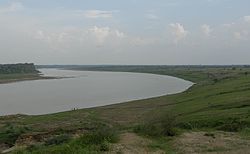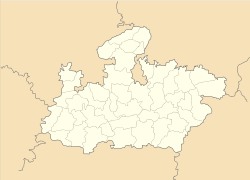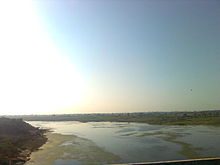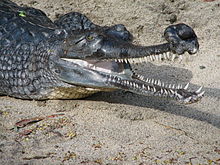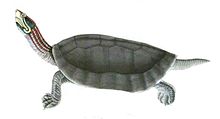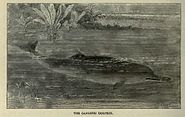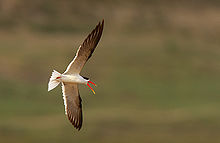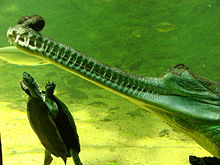- National Chambal Sanctuary
-
National Chambal Sanctuary
National Chambal (Gharial) Wildlife Sanctuary
— wildlife sanctuary — IUCN Category IV (Habitat/Species Management Area)Chambal Sanctuary near Dhaulpur Coordinates 26°40′N 78°57′E / 26.667°N 78.95°ECoordinates: 26°40′N 78°57′E / 26.667°N 78.95°E Country India State Madhya Pradesh Established 1979 Nearest city Agra 70 km (43 mi) Time zone IST (UTC+05:30) Area 5,400 square kilometres (2,100 sq mi) Climate
• Precipitation
Temperature
• Summer
• WinterCwa (Köppen)
• 880 mm (35 in)
• 42.6 °C (108.7 °F)
• 24.5 °C (76.1 °F)Governing body Madhya Pradesh Forest Department[1] Rajasthan Forest Department[2] Uttar Pradesh Forest Department[3] Website National Chambal Sanctuary National Chambal Sanctuary, also called the National Chambal Gharial Wildlife Sanctuary, is a 5,400 km2 (2,100 sq mi) protected area for critically endangered Gharial Crocodiles and the Red-crowned roof turtle and the endangered Ganges River Dolphin. Located near Etawah in Uttar Pradesh, North India. It was declared in 1979 and constitutes a long narrow tri-state eco-reserve co-administered by the states of Rajasthan, Madhya Pradesh and Uttar Pradesh. The pristine Chambal river cuts through mazes of ravines and hills and leaves many sandy beaches throughout the 425 km (264 mi) long sanctuary.
Contents
Geography
The 5,400 km2 (2,100 sq mi) National Chambal Gharial Sanctuary is located along approximately 425 km (264 mi) of the Chambal River and its ravines and varies between 1 km (0.62 mi) to 6 km (3.7 mi) wide centered on the river. It lies centered at 26°40′25″N 78°57′0″E / 26.67361°N 78.95°E. It consists of the large arc described by the Chambal river between Jawahar Sagar Dam at 25°2′14″N 75°40′41″E / 25.03722°N 75.67806°E in Rajasthan and the Chambal-Yamuna rivers confluence at 26°29′38″N 79°14′58″E / 26.49389°N 79.24944°E in Uttar Pradesh.
Along this arc, two stretches of the Chambal river are protected as the National Chambal Sanctuary. The upper sector centered at 25°6′25″N 75°45′10″E / 25.10694°N 75.75278°E, extends about 27 km (17 mi) from Jawahar Sagar Dam to Kota Barrage, and the lower sector, below a 19 km (12 mi) gap at Kota city, extends about 567 km (352 mi) from Keshoraipatan in Rajasthan to the Chambal-Yamuna rivers confluence near Bhareh town, Etawah district (formerly Auraiya district), Uttar Pradesh.[4]
History
Administrative approval of the Government of India for the establishment of the National Chambal Sanctuary was conveyed in Order No. 17-74/77-FRY (WL) dated 30 September 1978. The Sanctuary has sanctuary status declared under Section 18(1) of the Wildlife Protection Act of 1972. Since such a declaration is carried out by individual states for territory falling within their jurisdiction, there are three separate notifications covering the National Chambal Sanctuary - the Madhya Pradesh portion was gazetted in the Government of Madhya Pradesh Notice No. F.15/5/77-10(2) dated 20 December 1978, the Uttar Pradesh portion was gazetted in the Government of Uttar Pradesh Notice No. 7835/XIV-3-103-78 dated 29 January 1979 and the Rajasthan portion was gazetted in the Government of Rajasthan Notice No.F.11(12)Rev.8/78 dated 7 December 1979.[4]
The sanctuary is protected under India's Wildlife Protection Act of 1972. The sanctuary is administered by the Department of Forest under the Project Officer with headquarters at Morena, Madhya Pradesh.
Wildlife
The Critically endangered Gharial crocodile and the Red-crowned roof turtle live here, and together with the endangered Ganges River Dolphin are the keystone species of the sanctuary. Other large threatened inhabitants of the sanctuary include Muggar crocodile, Smooth-coated Otter, Striped Hyaena and Indian Wolf. Chambal supports 8 of the 26 rare turtle species found in India, including Indian narrow-headed softshell turtle, Three-striped roof turtle and Crowned river turtle. Other reptiles who live here are: Indian flapshell turtle, Soft Shell turtle, Indian roofed turtle, Indian tent turtle and Monitor lizard.[5]
Mammals of less concern who live here include: Rhesus Macaque, Hanuman Langur, Golden Jackal, Bengal Fox, Common Palm Civet, Indian Small Mongoose, Indian Grey Mongoose, Jungle cat, Wild Boar, Sambar, Nilgai, Blackbuck, Indian Gazelle (Chinkara), Northern Palm Squirrel, Porcupine, Indian Hare, Indian Flying Fox and Hedgehog.[5]
The National Chambal Sanctuary is listed as an important bird area (IBA) IN122.[6] and is a proposed Ramsar site. At least 320 species of resident and migratory birds inhabit the sanctuary. Migratory birds from Siberia form part of its rich avian fauna.[3] Vulnerable bird species here include the Indian skimmer.[7], Sarus Crane, Pallas's Fish Eagle and Indian Courser. The Pallid Harrier and Lesser Flamingos here are near threatened. Winter visitors include Black-bellied Terns, Red-crested Pochard and Ferruginous Pochard and Bar-headed Goose. Other species include Great Thick-knee, Greater Flamingos, Darters, and Brown Hawk Owl.[3]
Common plants in the sanctuary include Khair (Mimosa catechu Acacia catechu), Palash (Flame of the Forest Butea monosperma), Churel (Indian Elm Tree Holoptelia integrifolia), Ber (Indian Plum Ziziphus mauritiana) and Grassy patches on both sides of the river.[2]
Conservation management
The sanctuary is protected under India's Wildlife Protection Act of 1972. The sanctuary is administered by the Department of Forest under the Project Officer with headquarter at Morena, Madhya Pradesh.
Parts of the sanctuary are threatened by extensive illegal sand mining, which is endangering the fragile lotic ecosystem critical for Gharial breeding.
On December 27, 2010, the Minister for Environment and Forests, Jairam Ramesh, during a visit to the Madras Crocodile Bank, announced the formation of a National Tri-State Chambal Sanctuary Management and Coordination Committee for gharial conservation on 1,600 km2 (620 sq mi) of the National Chambal Sanctuary. The Committee members will comprise representatives of three states' Water Resources Ministries, states' Departments of Irrigation and Power, Wildlife Institute of India, Madras Crocodile Bank, the Gharial Conservation Alliance, Development Alternatives, Ashoka Trust for Research in Ecology and the Environment, Worldwide Fund for Nature and the Divisional Forest officers of the three states. The Committee will plan strategies for protection of gharials and their habitat. It will conduct further research on the species and its ecology and evaluate the related socio-economic elements of dependent riparian communities. Funding for this new initiative will be mobilized as a sub-scheme of the ‘Integrated Development of Wildlife Habitats’ in the amount of Rs. 50 to 80 million (USD 1 million to 1.7 million) each year for five years. This project has long been advocated by herpetologist Rom Whitaker.[8][9]
Visitor activities
There are many nature watching opportunities available for the visitors to the National Chambal Sanctuary. The best opportunities for sighting and photography of Gharial and Dolphins can be had by hiring a boat with experienced driver and guide, available at several points along the river. A boat excursion will also offer many good viewpoints for photography of water and shore birds and unique landscapes. Walking trails in the ravines and along the river offer opportunities for close observation of the wide variety of plants and animals in the Sanctuary.[3]
There are public vehicle entry points to Chambal Sanctuary at Pinahat, Nandagon Ghat, Sehson and Bharch. Boating and visiting arrangements can be made with the help of the Wildlife Conservator Office, at Kota.[2][10]
Visitors may explore Ater Fort, a beautiful but dilapidated landmark and historical site near Ater town, 35 km from Bhind. The fort was built by the Bhadauria kings Badan Singh, Maha Singh and Bakhat Singh in 1664-1698. The fort is situated on the banks of the Chambal River and can be reached by bus, jeep or boat.
There are Forest Rest Houses at Bah and Chakkar Nagar and Public Works Department Inspection Bungalows at Bah and Pinahat. There are several commercial hotels and Eco Lodges at Agra, Etawah and Bah.[3] The nearest airport is at Agra. The nearest railway station is at Agra. Agra and Mathura are major rail junctions with a number of trains from all over the country. Bharatpur, Ranthambhor National Park (with change at Bharatpur), Bandhavgarh National Park (Katni, Umaria) and Kanha National Park (Jabalpur) are all well serviced by the rail network from Agra.[10]
References
- ^ "Chambal Sanctuary". Madhya Pradesh Forest Department. http://www.mpforest.org/chambal.html. Retrieved 2010-12-28.
- ^ a b c "National Chambal". Rajasthan Forest Department. http://www.rajforest.nic.in/national_chambal.htm. Retrieved 28 December 2010.
- ^ a b c d e "National Chambal Sanctuary". Wildlife wing of the Uttar Pradesh Forest Department. http://nationalchambalsanctuary.in/index.html. Retrieved 2010-12-28.
- ^ a b Sale J.B. 1982. 2nd Draft. Management Plan For The National Chambal Sanctuary. First Five Year Period 1982/83 - 1986/87. Central Crocodile Breeding and Management Institute, Hyderabad.
- ^ a b "Reptiles & Mammals, Checklist of National Chambal Sanctuary". Wildlife wing of the Uttar Pradesh Forest Department. http://nationalchambalsanctuary.in/check_list.html. Retrieved 2010-12-28.
- ^ "IN122 National Chambal Wildlife Sanctuary (Agra/Etawah)". Sites - Important Bird Areas (IBAs). BirdLife International. http://www.birdlife.org/datazone/sitefactsheet.php?id=18426. Retrieved 2010-12-29.
- ^ "National Chambal Sancuary". Birds of India. Kolkata Birds. http://www.kolkatabirds.com/chambal.htm. Retrieved 2010-12-29.
- ^ Lenin, Janaki (1010-12-27). "New Government of India initiative for gharial conservation". Janaki Lenin's Facebook Notes (Madras Crocodile Bank, Chennai, India). http://www.facebook.com/note.php?note_id=152136454836182.
- ^ Oppilli, P. (2010-12-27). "A sanctuary Coming Up for Ghariyals". S & T, ENERGY & ENVIRONMENT (The Hindu, Chennai). http://www.thehindu.com/sci-tech/energy-and-environment/article995890.ece. Retrieved 2010-12-27.
- ^ a b "Maps of National Chambal Sanctuary". Wildlife wing of the Uttar Pradesh Forest Department. http://nationalchambalsanctuary.in/maps.html. Retrieved 2010-12-28.
External links
Kanpur division topics General - Doab
- Dainik Jagaran
- National Chambal Sanctuary
- Lakh Bahosi Sanctuary
Mythology, history Districts - Auraiya
- Etawah
- Farrukhabad
- Kannauj
- Kanpur
- Ramabai Nagar
Rivers, dams, lakes - Chambal
- Ganges
- Kali
- Ramganga
- Sindh
- Yamuna
- Ganges Barrage
- Moti Jheel
Languages, people - Awadhi
- Braj Bhasa
- Hindi
- Hindi-Urdu
- Kannauji
- Khariboli
- Standard Hindi
- Urdu
Transport - NH 2
- Grand Trunk Road
- NH 26
- NH 86
- NH 96
- Kanpur Airport
- IIT Kanpur Airport
- Kanpur Civil Airport
- Kanpur Central
- Kanpur Anwarganj
- Howrah-Delhi main line
- Lucknow-Kanpur Suburban Railway
- Kanpur Metro
- Kanpur Metropolitan Bus Service
Industries - Panki Thermal Power Station
- Lohia Machinery Limited
- Artificial Limbs Manufacturing Corporation of India
- British India Corporation
- Rupani Footwear
Institutes of higher learning - Indian Institute of Technology Kanpur
- Chhatrapati Sahu Ji Maharaj University
- Chandra Shekhar Azad University of Agriculture & Technology
- Harcourt Butler Technological Institute
- Uttar Pradesh Textile Technology Institute
- University Institute of Engineering and Technology, Kanpur University
- List of engineering colleges in Kanpur
- Ganesh Shankar Vidyarthi Memorial Medical College
Lok Sabha constituencies See also - Cities and towns in Auraiya district
- Cities and towns in Etawah district
- Cities and towns in Farrukhabad district
- Cities and towns in Kannauj district
- Cities and towns in Kanpur district
- Cities and towns in Ramabai Nagar district
- Villages in Auraiya district
- Villages in Etawah district
- Villages in Farrukhabad district
- Villages in Kannauj district
- Villages in Kanpur district
- Villages in Kanpur Dehat district
- People from Etawah
- People from Farrukhabad
- People from Kanpur
- People from Kanpur Dehat
- Kanpur topics
Other Divisions - Agra
- Aligarh
- Allahabad
- Azamgarh
- Bareilly
- Basti
- Chitrakoot
- Devipatan
- Faizabad
- Gorakhpur
- Jhansi
- Lucknow
- Meerut
- Mirzapur
- Moradabad
- Saharanpur
- Varanasi
Categories:- IUCN Category IV
- Chambal River
- Wildlife sanctuaries in Rajasthan
- Wildlife sanctuaries in Uttar Pradesh
- Wildlife sanctuaries in Madhya Pradesh
Wikimedia Foundation. 2010.

